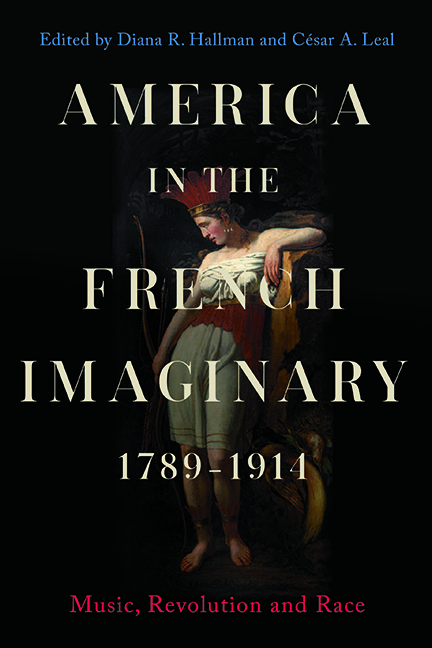Book contents
- Frontmatter
- Dedication
- Contents
- List of Illustrations
- List of Music Examples
- List of Abbreviations
- Editorial Notes
- List of Contributors
- Acknowledgements
- Preface
- Introduction
- Part I American liberté, sauvagerie and esclavage
- Part II Myths of America and Intersecting Identities
- Part III Soundscapes and Sonic Fantasies
- Part IV America, Commodification and Race at the fin de siècle
- Bibliography
- Index
- Music in Society and Culture
8 - La Liberté éclairant le monde: Transatlantic Soundscapes for the Statue of Liberty
Published online by Cambridge University Press: 15 September 2022
- Frontmatter
- Dedication
- Contents
- List of Illustrations
- List of Music Examples
- List of Abbreviations
- Editorial Notes
- List of Contributors
- Acknowledgements
- Preface
- Introduction
- Part I American liberté, sauvagerie and esclavage
- Part II Myths of America and Intersecting Identities
- Part III Soundscapes and Sonic Fantasies
- Part IV America, Commodification and Race at the fin de siècle
- Bibliography
- Index
- Music in Society and Culture
Summary
On 25 April 1876, the Union Franco-Américaine held a well-publicised fundraiser in Paris at the newly opened Palais Garnier for a monument that would become the Statue of Liberty. This massive sculpture was a transatlantic civic project that had been in the works since the end of the American Civil War in 1865, intended to celebrate political freedom, and in particular the abolition of slavery, while also reaffirming Franco-American friendship, an alliance famously forged in the crucible of the American Revolutionary War. Taking place in a theatre decorated with American and French flags, with a backdrop painted by Jean-Baptiste Lavastre that showed the projected statue in New York Harbor, the gala event attracted a veritable who’s-who of Franco-American grandeur – from Lafayette's grandson, Oscar de Lafayette, to the United States Minister to France, Elihu B. Washburne. For its musical portion, the celebration featured a cantata written for the occasion by Charles Gounod, La Liberté éclairant le monde, as well as several other musical items, including the American anthem ‘Hail, Columbia’. Yet despite all of these efforts, the fundraiser turned out to be but a lukewarm accomplishment, both financially and artistically, simultaneously competing for attention with such major theatrical events as Giuseppe Verdi's Aida, which had its premiere three days earlier, on 22 April, and continued to draw the public and critics into the Théâtre-Italien.
Despite its modest impact, however, the 1876 fundraiser counts among the better-known musical events in the transatlantic story of the Statue of Liberty. The saga of this monument began in the early summer of 1865 around a dinner table at the home of the French legal scholar and abolitionist Edouard de Laboulaye (1811‒83). Among the guests were not only Lafayette's grandson Oscar and Alexis de Tocqueville's brother Hippolyte, but also a young sculptor, Frédéric-Auguste Bartholdi (1834‒1904). Given that Napoléon III had backed the Confederacy, this group of liberal supporters of the North and admirers of Lincoln resolved then and there to find a way tangibly to show French loyalty to the reasserted ideals of the victorious American republic. It would take until 1871, however, for the project and Bartholdi's design to crystallise into the idea of a colossal female statue for New York Harbor, and a few more years to bring on board the somewhat reluctant Americans who considered the gift something of an imposition.
- Type
- Chapter
- Information
- America in the French Imaginary, 1789-1914Music, Revolution and Race, pp. 233 - 262Publisher: Boydell & BrewerPrint publication year: 2022



